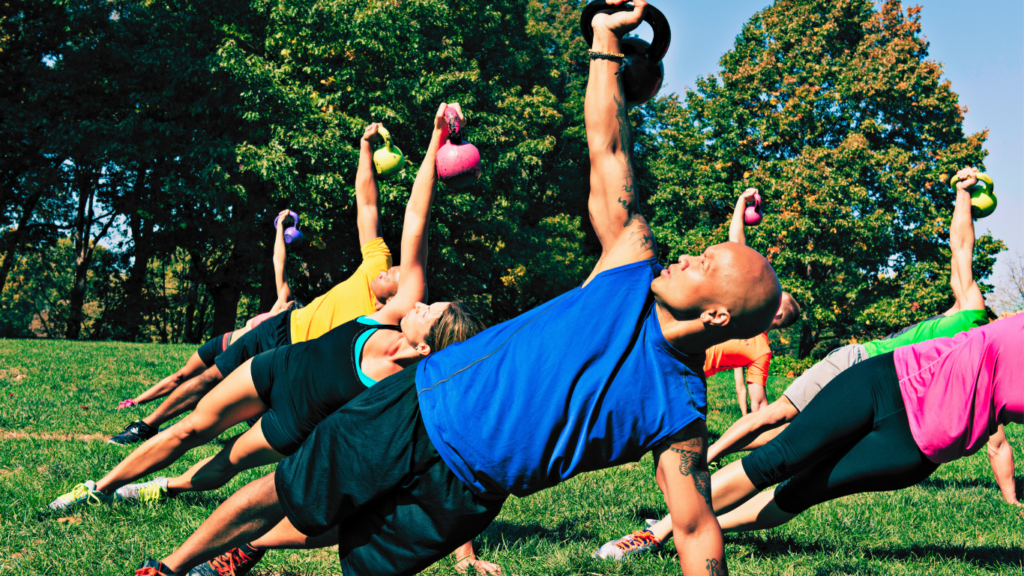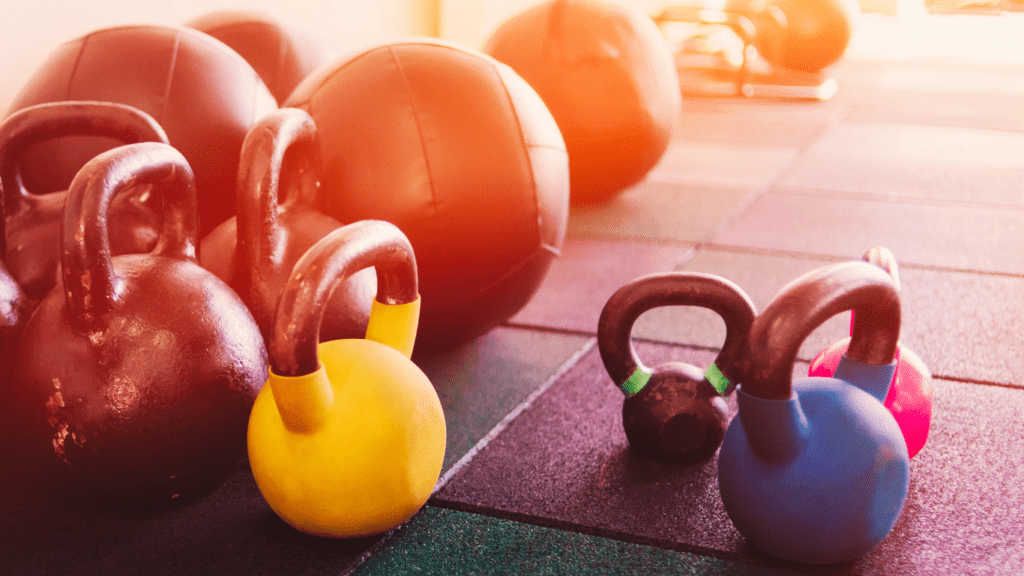Benefits of Kettlebell Training: Enhancing Strength, Mobility, and Fitness
In this article, we will uncover the benefits of kettlebell training, revealing how this powerful workout can enhance your strength, improve overall fitness, and transform your exercise routine.
In the realm of fitness, where efficiency meets effectiveness, benefits of kettlebell training stand out as a formidable choice for enthusiasts aiming to sculpt their bodies and improve overall strength. Imagine this: according to recent studies, kettlebell workouts can burn up to 20 calories per minute, surpassing traditional cardio exercises like running or cycling. This astonishing fact underscores the potency of kettlebells in transforming fitness routines.
Kettlebells, originally from Russia in the 1700s, were used as counterweights for measuring crops. Over time, their versatility and effectiveness in physical training became evident. These cannonball-shaped weights with handles soon became synonymous with strength and endurance training across the globe.
Today, benefits of kettlebell training have gained widespread recognition among fitness aficionados and professionals alike. The essence lies in their ability to engage multiple muscle groups simultaneously, promoting functional strength that translates into real-life activities. Unlike many gym machines that isolate muscles, kettlebells foster integrated movements, enhancing coordination and proprioception.
The primary allure of kettlebell workouts lies in their efficiency. A single session can encompass cardio, strength training, and flexibility exercises. This all-in-one approach not only saves time but also accelerates calorie burning and muscle building. Moreover, the dynamic nature of kettlebell movements enhances core stability and grip strength, which are vital for maintaining balance and preventing injuries.

One of the key benefits of kettlebell training is its adaptability to various fitness levels. Whether you’re a novice or an experienced athlete, kettlebells offer scalable intensity levels through adjustments in weight and movement complexity. This versatility makes them suitable for anyone looking to enhance their physical conditioning, from athletes aiming to improve sports performance to individuals seeking weight loss or rehabilitation from injuries.
Furthermore, kettlebell workouts foster a unique blend of cardiovascular and muscular endurance. By incorporating ballistic movements such as swings, snatches, and cleans, these exercises elevate heart rate while building lean muscle mass. This dual-action effect not only improves overall fitness but also boosts metabolism, leading to sustained calorie burn even after the workout ends.
Subscribe And Get Our Free E-Book:Unlocking The Power Of Nutrition-Supplements, Substitutes, and Superfoods!
Beyond physical gains, benefits of kettlebell training extend to mental well-being. The rhythmic, flowing motions of kettlebell exercises can induce a meditative state, promoting mindfulness and reducing stress levels. This mental clarity and focus can be invaluable in today’s fast-paced world, where balancing work, fitness, and personal life is a constant challenge.
In essence, kettlebell training transcends mere physical exercise; it becomes a holistic approach to fitness and well-being. By integrating strength, cardio, and flexibility into one comprehensive workout, kettlebells offer a streamlined path to achieving fitness goals efficiently. Whether aiming for weight loss, muscle tone, or overall health improvement, embracing the benefits of kettlebell training can revolutionize your fitness journey.
In the upcoming segments of this article, we will delve deeper into the nature of this workout, specific kettlebell exercises and their targeted benefits, providing practical insights to maximize your workout regimen. Stay tuned to unlock the full potential of kettlebell training and elevate your fitness experience to new heights.
What Happens To Your Body If You Exercise With Kettlebells Daily Video
Beyond the Basics
As we delve deeper into the realm of fitness, the profound benefits of kettlebell training continue to shine bright. In this segment, we will uncover the specific advantages that kettlebell workouts offer, focusing on their unique contributions to strength, conditioning, and overall physical fitness.
Strength and Conditioning Benefits
At the heart of kettlebell training lies its unparalleled ability to enhance both strength and conditioning simultaneously. Unlike conventional weightlifting, which often isolates specific muscle groups, kettlebell exercises engage multiple muscles in integrated movements. This holistic approach not only promotes balanced muscle development but also improves overall muscular endurance and cardiovascular health.
The distinctive design of kettlebells, with their off-centered weight distribution, plays a pivotal role in this process. When performing swings, cleans, or snatches, the body must counterbalance the shifting weight, compelling stabilizer muscles to work harder. This engagement not only strengthens these often-neglected muscles but also enhances coordination and proprioception, crucial for athletic performance and injury prevention.
Functional Strength
Perhaps one of the most touted benefits of kettlebell training is its emphasis on functional strength. Unlike static machines that restrict movement to a single plane, kettlebell exercises mimic real-life activities that require coordination, balance, and core stability. Movements such as the Turkish get-up or the kettlebell swing demand a synchronized effort from multiple muscle groups, translating directly into improved performance in daily tasks and sports activities.
By focusing on dynamic movements that incorporate full-body engagement, kettlebells foster a more natural range of motion. This not only strengthens muscles but also enhances joint flexibility and mobility, facilitating smoother, more efficient movements in everyday life.
Muscle Endurance
When it comes to muscular endurance, kettlebell training stands out as a game-changer. Traditional weightlifting typically involves static contractions that primarily target fast-twitch muscle fibers, essential for explosive strength. In contrast, kettlebell exercises integrate both slow and fast-twitch muscle fibers through continuous, rhythmic movements.

Swings, snatches, and presses performed with kettlebells not only build muscular endurance but also elevate heart rate, promoting cardiovascular conditioning. This dual-action effect results in improved stamina and sustained energy levels throughout prolonged physical activities. Whether you’re aiming to conquer a marathon or simply maintain peak performance during daily chores, the endurance benefits of kettlebell workouts prove invaluable.
In essence, the benefits of kettlebell training extend far beyond the realm of traditional weightlifting. They encompass a comprehensive approach to physical fitness that integrates strength, endurance, flexibility, and cardiovascular health. By harnessing the unique mechanics of kettlebells and embracing functional strength principles, individuals can optimize their fitness journey and achieve remarkable results.
Cardiovascular and Fat Burning Benefits
As we continue our exploration into the multifaceted benefits of kettlebell training, we shift our focus to the profound impact it has on cardiovascular health and fat burning. Beyond mere strength and conditioning, kettlebell workouts emerge as a dynamic tool for achieving comprehensive fitness goals.
Cardiovascular Conditioning
One of the defining benefits of kettlebell training is its ability to combine cardiovascular conditioning with strength training in one seamless workout. Unlike traditional cardio exercises such as running or cycling, which primarily focus on aerobic capacity, kettlebell exercises like swings, cleans, and snatches elevate heart rate while simultaneously engaging major muscle groups.
The ballistic nature of kettlebell movements demands explosive power and endurance, triggering a significant cardiovascular response. This dual-action approach not only improves heart health and circulation but also enhances overall endurance and stamina. By integrating cardio and strength components into a single session, kettlebell training offers a time-efficient solution for boosting cardiovascular fitness without compromising muscle gains.
Metabolic Impact
In the quest for effective fat loss and lean muscle development, kettlebell training emerges as a formidable ally. The metabolic advantages of kettlebell exercises lie in their ability to stimulate multiple muscle groups through dynamic, full-body movements. As muscles work harder to stabilize and propel the kettlebell, the body’s metabolic rate increases, promoting calorie burn during and after the workout.
Furthermore, kettlebell workouts promote lean muscle mass development, which plays a crucial role in sustaining a high metabolic rate. Unlike steady-state cardio, which primarily burns calories during the activity, kettlebell training induces a metabolic cascade that continues to torch calories long after the workout concludes. This phenomenon, known as excess post-exercise oxygen consumption (EPOC), enhances fat oxidation and promotes metabolic efficiency over time.
Interval Training
High-intensity interval training (HIIT) has gained popularity for its efficiency in maximizing calorie burn and improving cardiovascular health. Kettlebell training lends itself perfectly to HIIT protocols due to its inherent versatility and intensity. By alternating periods of high-intensity kettlebell exercises with brief recovery intervals, individuals can achieve significant fitness gains in a shorter timeframe.
The effectiveness of kettlebell HIIT lies in its ability to elevate heart rate quickly and sustainably, fostering an anaerobic environment that promotes fat loss and muscle conditioning. Exercises like kettlebell swings, snatches, and high pulls are particularly effective for HIIT due to their explosive nature and metabolic demands. This structured approach not only improves cardiovascular endurance but also enhances muscular strength and power, making it a well-rounded training method for athletes and fitness enthusiasts alike.
In summary, the benefits of kettlebell training extend beyond traditional fitness paradigms, offering a comprehensive approach to cardiovascular conditioning and fat burning. By harnessing the metabolic impact of dynamic kettlebell exercises and integrating them into structured interval training formats, individuals can optimize their workout efficiency and achieve accelerated results. Whether aiming to shed excess weight, enhance cardiovascular health, or improve overall fitness levels, kettlebell training stands as a versatile and effective solution.
Enhancing Mobility and Flexibility Through Kettlebell Training
In our ongoing exploration of the transformative benefits of kettlebell training, we turn our attention to its profound impact on mobility and flexibility. Beyond strength and cardiovascular conditioning, kettlebell exercises offer unique advantages in promoting joint health, enhancing range of motion, and mitigating injury risks.
Range of Motion
One of the hallmark benefits of kettlebell training lies in its ability to enhance joint mobility and flexibility. Unlike static exercises that focus solely on muscle contraction, kettlebell movements require fluid, multi-directional motions that engage muscles and joints through their full range of motion. Exercises such as windmills, Turkish get-ups, and halos promote dynamic stretching of muscles and tendons, thereby improving flexibility over time.

By consistently performing kettlebell exercises that challenge flexibility, individuals can unlock tight muscles, release tension, and improve overall joint function. This flexibility not only enhances athletic performance but also facilitates daily activities such as bending, reaching, and twisting with greater ease and efficiency.
Dynamic Movements
The dynamic nature of kettlebell exercises underscores their impact on overall mobility. Unlike traditional weightlifting exercises that often isolate specific muscle groups, kettlebell workouts incorporate swinging, rotating, and pressing motions that engage multiple muscle groups simultaneously. These dynamic movements not only improve strength and coordination but also encourage the body to adapt to varying movement patterns, enhancing neuromuscular efficiency.
Movements like kettlebell swings, cleans, and presses require coordinated efforts from the core, hips, and shoulders, fostering integrated strength and flexibility. This functional approach to fitness translates into improved agility and balance, essential for navigating everyday challenges and enhancing athletic performance.
Injury Prevention
Improved flexibility and mobility fostered by kettlebell training play a crucial role in injury prevention. By maintaining optimal joint mobility and flexibility, individuals can reduce the risk of strains, sprains, and other musculoskeletal injuries. The controlled, fluid movements inherent in kettlebell exercises promote joint stability and resilience, ensuring that muscles and connective tissues are primed for safe and effective movement.
Furthermore, the balanced development of muscles through kettlebell training helps correct muscular imbalances that can contribute to injury. Strengthening stabilizer muscles around joints enhances their ability to support and protect the body during physical activities, whether in sports or daily routines.
The benefits of kettlebell training extend far beyond strength and cardiovascular conditioning. By prioritizing flexibility and mobility through dynamic kettlebell movements, individuals can optimize their physical performance and minimize the likelihood of injury. Whether aiming to enhance athletic prowess, recover from injury, or simply improve overall quality of life, integrating kettlebell exercises into your fitness regimen offers a proactive approach to achieving these goals.
Exploring the Mental and Functional Benefits of Kettlebell Training
As we explore the multifaceted benefits of kettlebell training, we uncover its profound impact on mental well-being and functional fitness. Beyond physical strength and cardiovascular health, kettlebell exercises offer unique advantages that enhance overall mind-body integration, functional movement patterns, and adaptability to diverse fitness goals.
Mind-Body Connection
One of the most compelling benefits of kettlebell training is its ability to foster a strong mind-body connection. Engaging in kettlebell workouts involves more than just physical exertion; it requires mental focus, concentration, and mindfulness. The rhythmic, flowing movements of exercises like swings, snatches, and Turkish get-ups promote a meditative state that alleviates stress, improves mood, and enhances overall mental clarity.

Studies have shown that regular physical activity, such as kettlebell training, stimulates the release of endorphins—natural mood elevators that reduce stress and anxiety levels. This physiological response not only promotes a sense of well-being but also boosts cognitive function, enabling individuals to approach daily challenges with heightened focus and resilience.
Functional Fitness
Central to the allure of kettlebell training is its emphasis on functional fitness. Unlike traditional weightlifting exercises that isolate muscles in controlled environments, kettlebell workouts simulate real-life movements that require coordination, balance, and core stability. Exercises such as kettlebell swings mimic the motion of lifting and swinging objects, preparing the body for practical activities encountered in daily life or sports.
By integrating functional movements into fitness routines, individuals improve their ability to perform tasks efficiently and safely. Whether lifting groceries, playing with children, or participating in recreational sports, the enhanced functional fitness derived from kettlebell training translates directly into improved quality of life and reduced risk of injury.
Adaptability
One of the key benefits of kettlebell training is its adaptability to various fitness levels and goals. Whether you’re a beginner starting your fitness journey or an experienced athlete seeking to enhance performance, kettlebell exercises can be tailored to meet individual needs. By adjusting the weight, intensity, and complexity of movements, individuals can progress gradually and challenge themselves effectively over time.

Moreover, the versatility of kettlebell workouts allows for creativity in designing comprehensive fitness programs. From cardiovascular conditioning and strength training to flexibility and mobility enhancement, kettlebells offer a holistic approach to fitness that accommodates diverse preferences and objectives. This adaptability not only keeps workouts engaging and motivating but also promotes long-term adherence to a healthy lifestyle.
The benefits of kettlebell training extend far beyond physical fitness, encompassing mental well-being, functional movement patterns, and personalized adaptability. By integrating kettlebell exercises into your fitness regimen, you harness the power to strengthen both body and mind, enhancing overall health and vitality. Whether seeking stress relief, improved coordination, or versatile workout options, kettlebell training emerges as a versatile and effective solution.
Comparative Analysis: Kettlebell Training vs. Other Exercise Types
Versatility and Adaptability
To better understand the effectiveness of kettlebell training, it’s essential to compare its versatility and adaptability with other popular exercise modalities. The chart below illustrates how kettlebell training stacks up against running, cycling, swimming, jumping rope, and rowing in terms of its ability to meet diverse fitness needs:
Chart: Versatility and Adaptability of Exercise Types
| Exercise Type | Versatility | Adaptability | Primary Benefits |
|---|---|---|---|
| Kettlebell Training | High | High | Strength, cardio, flexibility, mental clarity |
| Running | Medium | Medium | Cardiovascular endurance, calorie burn |
| Cycling | Medium | Medium | Cardiovascular endurance, lower body strength |
| Swimming | High | High | Full-body workout, joint mobility |
| Jumping Rope | Medium | Medium | Cardiovascular fitness, agility |
| Rowing | High | High | Full-body workout, cardiovascular endurance |
Key Insights:
- Versatility: Kettlebell training integrates strength, cardio, flexibility, and mental clarity.
- Adaptability: Kettlebell exercises adjust to various fitness levels and goals.
- Primary Benefits: Each exercise type offers unique benefits.
Conclusion: Kettlebell training excels in versatility and adaptability for holistic fitness.
Key Takeaways:
- Kettlebell Training: Offers high versatility and adaptability, combining strength, cardio, flexibility, and mental clarity in one workout.
- Running and Cycling: Focus primarily on cardiovascular endurance and lower body strength, with moderate versatility.
- Swimming: Provides a full-body workout with high versatility and benefits for joint mobility.
- Jumping Rope: Enhances cardiovascular fitness and agility, suitable for varied fitness levels.
- Rowing: Offers a full-body workout and high adaptability for cardiovascular endurance and strength.
Conclusion: By understanding these comparisons, individuals can make informed choices based on their fitness goals and preferences. Whether aiming for comprehensive strength development, cardiovascular fitness, or flexibility enhancement, kettlebell training emerges as a versatile and effective option.
Practical Tips for Maximizing the Benefits of Kettlebell Training
As we delve further into the comprehensive benefits of kettlebell training, it’s crucial to equip ourselves with practical tips to ensure a safe and effective start. Whether you’re a newcomer or a seasoned fitness enthusiast, understanding how to select the right equipment and adhere to essential safety guidelines will enhance your kettlebell experience.
Choosing the Right Kettlebell
Selecting the appropriate kettlebell is the first step towards reaping the full benefits of kettlebell training. The weight of the kettlebell is critical and should be based on your current strength level and fitness goals. Beginners should start with a lighter weight to master the techniques before progressing to heavier weights. For women, a good starting point is usually an 8-12 kg kettlebell, while men might begin with a 12-16 kg kettlebell. As you gain strength and confidence, you can gradually increase the weight to continue challenging your muscles and improving your fitness.

Additionally, the type of kettlebell can impact your training. Cast iron kettlebells are standard and versatile for most exercises. Competition kettlebells, although uniform in size regardless of weight, are often preferred for their consistent feel and handle size, making them ideal for more advanced and high-repetition workouts. Whichever type you choose, ensure that the handle is smooth and free of burrs to prevent discomfort and injuries during use.
Safety Tips
Safety is paramount when engaging in any form of exercise, and kettlebell training is no exception. Adhering to essential safety precautions will help you avoid injuries and make the most of the benefits of kettlebell training.
Firstly, always warm up before starting your kettlebell workout. A proper warm-up increases blood flow to your muscles, enhances flexibility, and prepares your body for the intensity of the exercises. Dynamic stretches and light cardio activities like jogging or jumping jacks can effectively warm up your body.
Maintaining proper form throughout your kettlebell exercises is crucial. Incorrect form can lead to strains, sprains, and other injuries. For instance, during a kettlebell swing, ensure that you hinge at the hips rather than squatting, keep your back straight, and engage your core to protect your spine. If you’re unsure about your form, consider working with a certified kettlebell instructor who can provide guidance and corrections.
Start with basic exercises and gradually progress to more complex movements. Familiarize yourself with foundational exercises like the kettlebell swing, goblet squat, and Turkish get-up before attempting advanced routines. This approach helps build strength and coordination while minimizing the risk of injury.
Ensure you have adequate space around you to perform kettlebell exercises safely. Kettlebell movements, especially swings and snatches, require a clear area to avoid accidents or damage. Additionally, practice on a non-slip surface to maintain stability and prevent falls.
Listening to your body is essential. If you experience pain or discomfort during any exercise, stop immediately and assess your form or reduce the weight. Overtraining can lead to injuries and setbacks, so allow your body ample time to rest and recover between workouts.
Getting Started with Kettlebell Training
Now that you’re equipped with the knowledge to choose the right kettlebell and follow essential safety tips, let’s explore how to get started with your kettlebell training journey.
Begin with a structured workout plan that incorporates a variety of exercises targeting different muscle groups. A balanced routine should include exercises for the upper body, lower body, and core. For instance, you might perform kettlebell swings for overall conditioning, goblet squats for lower body strength, and Turkish get-ups for core stability and coordination.
Consistency is key to experiencing the full benefits of kettlebell training. Aim to incorporate kettlebell workouts into your fitness routine at least 2-3 times per week. Gradually increase the intensity and complexity of your workouts as you build strength and endurance.
Track your progress to stay motivated and make necessary adjustments to your training plan. Keeping a workout journal can help you monitor improvements in strength, flexibility, and overall fitness. Celebrate your achievements, no matter how small, as they contribute to your long-term fitness goals.
Finally, complement your kettlebell training with a balanced diet and adequate hydration. Proper nutrition fuels your workouts and aids in recovery, ensuring you can perform at your best and continue making progress.
The benefits of kettlebell training are manifold, encompassing physical strength, cardiovascular health, flexibility, and mental well-being. By selecting the right equipment, adhering to safety guidelines, and maintaining a consistent and structured training plan, you can unlock the full potential of kettlebell training and transform your fitness journey. Whether you’re aiming to build muscle, burn fat, or enhance overall functional fitness, kettlebells offer a versatile and effective solution to help you achieve your goals.
Harnessing the Full Benefits of Kettlebell Training for a Transformative Fitness Journey
As we wrap up our deep dive into the benefits of kettlebell training, it’s clear that incorporating this versatile tool into your fitness regimen can truly revolutionize your approach to health and wellness. From enhancing strength and conditioning, boosting cardiovascular health and fat burning, improving mobility and flexibility, to fostering mental and functional fitness, kettlebell training covers all bases. Now, let’s focus on why these benefits should inspire you to take action and embrace kettlebell training as a cornerstone of your fitness journey.
Comprehensive Comparison of Exercise Types Chart:
| Exercise Type | Calories Burned per Minute (average)* | Muscles Engaged | Cardiovascular Benefit | Functional Movement | Flexibility Enhancement | Mental Clarity |
|---|---|---|---|---|---|---|
| Kettlebell Training | Up to 20 calories | Multiple major muscle groups | High, due to dynamic movements | Yes, mimics real-life activities | Yes, promotes joint mobility | Yes, promotes mindfulness |
| Running (8 mph) | 13.5 calories | Lower body | High | Limited to repetitive motion | Limited | Yes, due to rhythmic activity |
| Cycling (20 mph) | 16 calories | Lower body | High | Limited to repetitive motion | Limited | Yes, due to rhythmic activity |
| Swimming (freestyle) | 12 calories | Full body | High | Dynamic, full-body | Yes, due to water resistance | Yes, calming effect |
| Jumping Rope | 15 calories | Full body | High | Dynamic, full-body | Yes, improves agility | Yes, focus on rhythm |
| Rowing (vigorous) | 12 calories | Full body | High | Dynamic, full-body | Yes, improves flexibility | Yes, focus on technique |
*Caloric expenditure based on a 150-pound individual performing each exercise at moderate intensity.
Insights:
- Calories Burned: Kettlebell training offers the highest caloric burn rate, up to 20 calories per minute, due to its integration of strength and cardio.
- Muscles Engaged: Kettlebell training engages multiple major muscle groups, enhancing overall strength and endurance.
- Cardiovascular Benefit: Kettlebell exercises provide high cardiovascular benefits similar to running and cycling.
- Functional Movement: Kettlebell exercises mimic real-life activities, promoting functional strength and coordination.
- Flexibility Enhancement: Kettlebell training contributes to joint mobility and flexibility, comparable to swimming and rowing.
- Mental Clarity: The rhythmic, flowing motions of kettlebell exercises promote mindfulness and reduce stress, akin to swimming and jumping rope.
Conclusion: Kettlebell training emerges as a versatile exercise option that not only burns calories effectively but also enhances strength, cardiovascular health, flexibility, and mental well-being.
Reflect on the strength and conditioning improvements you’ve read about. Imagine the power in knowing that each swing, lift, and squat not only builds your muscles but also hones your stabilizer muscles, contributing to a more balanced and injury-resistant body. This isn’t just about looking stronger; it’s about feeling empowered in your daily activities, moving with confidence, and enjoying the robustness that comes with well-rounded strength.
Consider the cardiovascular and fat-burning benefits. Visualize the efficiency of a workout that simultaneously challenges your heart and burns calories, paving the way for a leaner, healthier body. The metabolic boost you gain from kettlebell training can help you shed stubborn fat and build lean muscle, transforming not just your body, but also your overall health. Think of the energy and vitality that come from an efficient, heart-healthy workout that also keeps you lean and fit.
The mobility and flexibility gains are equally transformative. Picture yourself moving through life with greater ease and fluidity, your joints and muscles working harmoniously to prevent injuries and enhance performance. This newfound agility isn’t just for the gym—it’s for every step you take, every lift, every reach. Kettlebell training helps you build a body that is as functional as it is strong, capable of handling whatever life throws your way.
When it comes to mental and functional fitness, the benefits of kettlebell training extend beyond the physical. The mind-body connection fostered through kettlebell exercises can lead to improved focus, reduced stress, and a sense of mental clarity that is invaluable in today’s fast-paced world. The functional movements mimic real-life actions, making everyday tasks easier and more efficient. By incorporating kettlebell training into your routine, you’re not just working out; you’re preparing your body and mind for life’s challenges, enhancing your resilience and mental fortitude.
Getting started with kettlebell training is easier than you might think. With the right kettlebell, a commitment to safety, and a consistent routine, you can unlock the full spectrum of benefits. This isn’t just about achieving a temporary fitness goal—it’s about adopting a lifestyle that promotes long-term health and well-being.
To inspire you further, consider the limitless potential that lies within a simple piece of equipment. Kettlebells may seem modest, but their impact on your fitness can be profound. As Pavel Tsatsouline, a leading authority on kettlebell training, often emphasizes, the simplicity of kettlebells belies their power to transform. The kettlebell’s design and the dynamic nature of the exercises ensure that you are continually challenged, constantly improving, and always progressing toward a better version of yourself.
For those looking to dive deeper, there are numerous resources available. Books such as “Enter the Kettlebell!” and “Kettlebell Simple & Sinister” by Pavel Tsatsouline, and “The Complete Guide to Kettlebell Training” by Steve Cotter, offer valuable insights and detailed guidance. These texts can help you refine your technique, develop effective routines, and understand the science behind the movements, ensuring you make the most out of your kettlebell training.
In closing, the benefits of kettlebell training are vast and impactful, offering a holistic approach to fitness that is both effective and sustainable. By embracing kettlebell training, you’re not just working out; you’re committing to a healthier, stronger, and more balanced life. You’re building a body that is capable, resilient, and ready for anything. So, why wait? Take that first step, pick up a kettlebell, and embark on a journey that promises to transform your body, sharpen your mind, and enhance your overall well-being. Embrace the challenge, enjoy the process, and witness the remarkable changes that kettlebell training can bring to your life.


